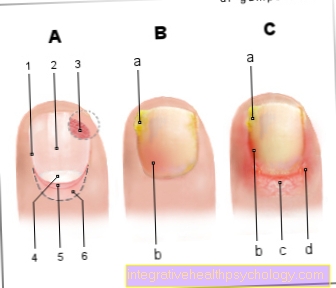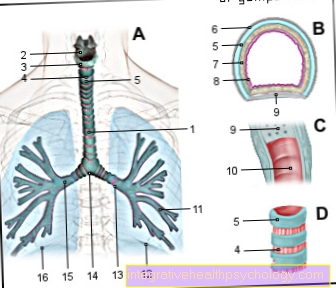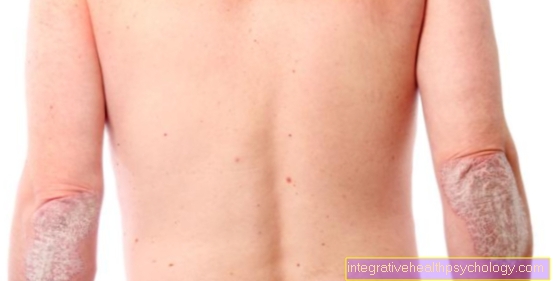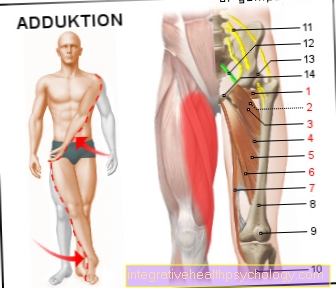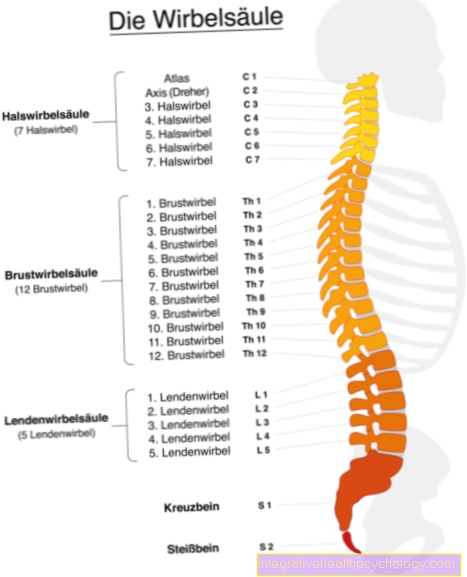Inflammation of the bags under the eyes (dacrocystitis)
definition
Under eye bags inflammation is the inflammation of the bags located on the inner corner of the eyelid. They are part of the tear drainage pathway. This type of inflammation can be acute as well as chronic.
.jpg)
Symptoms
An overview of the symptoms of inflammation of the bags under the eyes, not all of which occur at the same time:
- unilateral swelling of the lacrimal sac
- radiating pain (in the forehead and tooth region)
- Redness (also redness of the conjunctiva and lower eyelid)
- Pus from lower point of tear
- Fever in extreme cases
Typically, the symptoms of inflammation of the bags under the eyes appear unilaterally. However, a bilateral occurrence is also possible.
In terms of symptoms, a distinction has to be made between acute inflammation of the bags under the eyes and the long-standing (chronic) inflammation of the bags under the eyes. In the acute form, the main symptoms of inflammation are in the foreground. The area of the lacrimal sac, i.e. the region around the eye that faces the root of the nose (the so-called inner corner of the eyelid), is affected. A significant bulging swelling occurs in this area.
Furthermore, there is reddening and overheating of the area. A feeling of tension and quite pronounced pain appear in this area within a short time. The eye is extremely sensitive, which manifests itself in the fact that pain on touch or other mechanical stress on the eye, such as blinking, can be increased. It is also possible for the pain to radiate into the area around the eye. This can lead to pain development in the forehead or jaw area, but also in the teeth.
When pressure is applied to the bags under the eyes, a slimy or purulent discharge occurs. However, this measure should not be carried out by laypeople, as there is a risk of bacteria being carried over from the tear sac.
When an abscess forms, that is, a pus-filled cavity under the skin, the pus can find its way out. This so-called fistula in the area around the eye should also be taken seriously as a sign of tear sack inflammation.
Locally, the inflammation can lead to swelling of the lymph nodes in the head and neck area.Furthermore, conjunctivitis (Conjunctivitis) possible through pathogens that have reached the conjunctiva from the tear sac. In this case, the reddening of the eye combined with burning or itching may indicate an inflammation of the lacrimal sac.
In addition to the local inflammatory reaction, the entire body can also be involved, which can manifest itself in the form of a fever. Fortunately, however, this reaction is rarely encountered.
In contrast to the acute form of so-called dacrocystitis, the chronic form of this disease is often much less noticeable and is therefore often not recognized.
The typical signs of inflammation may be absent. Often the disease is only noticeable through tears in the eyes. Recurring or persistent conjunctivitis, usually confined to one eye, can also be a sign of chronic tear sack inflammation. A characteristic feature here is also the discharge when pressure is applied to the tear sac, as it also occurs in the acute form.
Therapy of inflammation of the bags under the eyes
The treatment of tear sack inflammation depends on the present one Underlying disease. If this is unclear, the pathogen will be detected Secretion and pus removed from the eye sac by applying slight pressure.
The ophthalmologist will refer the patient to exclusion one Sinus infection to the roentgen and / or to an ENT specialist. So that a wide spectrum of pathogens can be covered, local (ointment with gentamicin, e.g. Refobacin®) and systemic (e.g. dicloxacillin, e.g. Infectostaph®) Antibiotics given.
As soon as the pathogen has been identified, a antibiotic converted with a different spectrum of activity, if necessary. So one prevents chronic tear sack inflammation depends on the localization of the bottleneck operational a new direct link between Tear sac and lower nasal passage generated (Dacryocystorhinostomy).
Which ointment helps?
Eye ointments are particularly popular with eye sack infections. It is a thick paste that usually contains calming ingredients. A strip of this eye ointment can be inserted into the conjunctival sac on the lower eyelid several times a day. There the ointment can develop its anti-inflammatory effect on the bags under the eyes. If necessary, ointments that contain antibiotic agents should be used. These should be used if a bacterial infection is the cause of the tear sack inflammation.
Read more on this topic at: Eye drops and eye ointments and eye ointment with antibiotic
Homeopathy for inflammation of the bags under the eyes
In general, the inflammation of the eye sac is treated with antibiotic agents. The main one complaint an inflammation of the lacrimal sac is the Lacrimation, which deals with the homeopathic remedy Calendula officinalis D3 can be treated.
To control the inflammation as such is recommended Calcium sulfuricum C4 and C5. A dosage of 5 globules three times a day is recommended.
In addition, are suitable Belladonna D30, Apis D30 and Bryonia D4 for the topical treatment of tear sack infections. In the case of recurring complaints, it is possible to have therapy over a period of three months Staphisagria C15 to C30.
In addition, you can treat chronic tear sack inflammation with various other homeopathic remedies, depending on the type of inflammation. It is recommended for thin and purulent secretions Mercurius solubilis D30 once a day. If, on the other hand, the secretion is thick and purulent, then the remedy is of choice Hepar sulfuris D30, which should be taken twice a day. Silicea D12 can also be used to treat lacrimal sacs. It is particularly suitable for dry irritation with possibly a tear sac fistula.
Prognosis of untreated tear sack inflammation
The bacteria that cause inflammation of the bags under the eyes can also come from neighboring regions, such as the paranasal sinuses, or encapsulate in the bags under the eyes to form an abscess that can then break through spontaneously (Lacrimal sac fistula). If the infection spreads to the eyelid and cheek (Dakryophlegmon), there is a risk of blood poisoning (sepsis).
Once the acute tear sack infection has subsided, swelling and redness may persist. Such a chronic inflammation of the bags under the eyes (chronic dacryocystitis) but sometimes develops without a preceding acute phase.
Also read our topic: Abscess on the eye
Duration of inflammation of the bags under the eyes
As a rule, the swelling and thus also the inflammation of the tear sac should be over the course of a week go back. Is this Not the case you should doctor and get examined.
Should Pain, redness or fever at the same time then you definitely should on the same day or one more in the following days doctor consult.
How contagious is eye sack inflammation?
How contagious a tear sack inflammation is depends primarily on the cause of the inflammation. Blockages in the area of the tear duct can lead to inflammation of the tear sac. Allergic reactions with burning red eyes can also influence the bags under the eyes and cause inflammation of the bags. These complaints are not contagious.
If, on the other hand, there is an infectious process with viruses or bacteria, the tear sacs can be contagious. The pathogens can mainly be transmitted via smear infections. So if you have an infectious eye sack and rub your eye, you should wash your hands afterwards. If he does not do this, the viruses or bacteria can get from the hand to other surfaces (door handles, etc.) and from there onto other people's hands. If these people now take a look at themselves, they can also get inflammation of the eye and, as a result, possibly an inflammation of the lacrimal sac.
Cause of inflammation of the bags under the eyes
If you have an acute inflammation of the lacrimal sac (acute dacryocystitis) the exit of the tear sac is e.g. narrowed as a result of scarlet fever, chickenpox, or flu infection. The tear fluid can no longer drain properly, the eyes water and the tear sack becomes inflamed, since the pent up tear fluid is an ideal breeding ground for bacteria.
Inflammation of the lacrimal sack caused by a cold
A cold can lead to inflammation of the bags under the eyes through several mechanisms. If the nose is blocked by the cold, this can also clog the tear duct, which conducts tear fluid from the eye into the nose. This can lead to inflammation of the eyes and the bags under the eyes. However, the spread of pathogens (mostly viruses, less often bacteria) can also be the cause of the inflammation of the bags under the eyes. If the germs get from the nose into the eyes, inflammation is caused there, which can also spread to the bags under the eyes.
Inflammation of the bags under the eyes during pregnancy
If tear sack inflammation occurs during pregnancy, a simple course should first be tried Home remedies or homeopathic remedies avert or contain. Light massages The bags under the eyes can help to correct the cause of the inflammation. Against the swelling of the bags under the eyes cooling pads from cucumbers, washcloths, or cold, wrung-out tea bags to provide relief. Is particularly beneficial chamomile, in any form: cloths soaked in cold chamomile tea or cold tea bags support decongestion and have an antibacterial effect.
However, one should be timely doctor be visited when it becomes apparent that the Do not use home remedies to curb inflammation of the eye sac leaves. The doctor will antibiotic therapy adapt to the circumstances of the pregnancy. In general, in order to protect the baby, with every drug therapy the pregnant woman should check whether it is safe for the child to take the medication or seek advice from a doctor.
Inflammation of the bags under the eyes in the baby
Kick the Inflammation of the bags under the eyes in infancy on (then as neonatal dacrocystitis the cause is innate. It is about a Bottleneck in form of a Mucosal foldusually found in Course of development opens. This fold is in the area of the so-called Nasolacrimal duct, a naturally occurring one Connection between the corner of the eye and the nose. In healthy people, this is used to drain the tear fluid. If there is no opening, there is one Bottleneckthat obstructs the outflow of tear fluid. This creates a Tears accumulation. This offers the optimal basis for that Growth of bacteriacausing the tear sack inflammation.
Symptoms usually show up within the first couple of weeks after birth.
The Appearance of the lacrimal sac in infancy usually consists of one Protrusion of pus from the inner corner of the eye. This then accumulates on eyelid.
Becomes inflammation of the bags under the eyes determined by the doctor, the therapy usually consists initially in antibiotic and decongestant drops to be brought into the eyes and nose. The bottleneck often forms while waiting then back. It can also be repeated from the outside slight pressure be exercised on the bags under the eyes, which often causes the constriction to open. If these measures are unsuccessful, a short surgery under anesthesia become necessary to enable the unhindered drainage of the tear fluid. This usually solves the problem.



